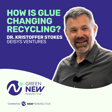
Hemp-Based Materials: Challenging the Norms of Construction
Welcome back to The Green New Perspective! Today, we're thrilled to be joined by Jonnie Pedersen, a forward-thinking expert in the world of sustainable building materials. Jonnie is the Growth Operations Specialist at Hempitecture, a company that uses industrial hemp to create sustainable building products that are better for the environment and for people.
💡KEY INSIGHTS
==================
🌱 Hemp-based materials have the potential to create sustainable building products that are better for the environment and for people.
🏗️ The building industry is facing challenges such as supply chain demands and the push to make new buildings Net Zero by 2030, highlighting the need for innovative solutions like hemp-based materials.
🌍 Energy efficiency measures, including the use of insulation, can contribute to achieving more than 40% of energy-related emission cuts needed to reach climate goals by 2040.
🌱 Industrial hemp is a regenerative crop that can be grown and harvested in just 90 days, making it a sustainable and efficient material for construction.
🌍 The concept of "Cradle to Gradle" emphasizes the importance of considering the entire lifecycle of materials, including their origin and disposal.
💚 The use of renewable energy resources, such as solar, hydro, and wind, in the manufacturing process of hemp-based materials contributes to a better planet and a better world for people.
🌱 Hemp-based materials faced initial skepticism and disbelief, but the legalization of hemp grow materials in the US in 2018 has opened up new possibilities for sustainable construction.
🌱 Partnerships with research institutions like the University of Idaho and the Department of Energy's Oak Ridge National Lab allow for rigorous testing of hemp-based materials' performance and carbon impact, ensuring their quality and sustainability.
🕑 KEY MOMENTS
==================
➜ 00:07 Hempitecture uses industrial hemp to create sustainable building products.
➜ 03:18 Energy efficiency is crucial for reducing emissions and achieving climate goals.
➜ 06:58 Hemp is a regenerative crop with multiple uses
➜ 10:10 Using industrial hemp as a building material is carbon negative
➜ 13:06 Hemp has the potential for various uses beyond just CBDs and THCs.
➜ 16:18 Building industry slow to adopt sustainable materials
➜ 19:08 Hemp wool is a scalable and accessible option for construction
➜ 22:01 Hope for a sustainable future with circular and reusable materials
🌍 SUSTAINABILITY PODCAST CREATED BY NEW PERSPECTIVE
========================
This podcast is proudly sponsored by New Perspective Marketing, a dynamic growth marketing agency in Boston, MA, celebrating 20 years in business. We help sustainably focused B2B organizations grow their brands and scale up revenue. If you or your organization is looking to grow, visit npws.com for more info.
🎧 SUBSCRIBE TO OUR PODCAST
===========================
- Spotify: https://bit.ly/3PSWIyI
- Apple Podcasts: https://bit.ly/3RvlHte
- Youtube: https://bit.ly/3RDzkXg
- Google Podcasts: http://bit.ly/465gjS5
- Deezer: https://bit.ly/3PvQaof
- Amazon Music: https://bit.ly/3PQlijS
- Zencastr: https://bit.ly/48xt75s
💬 FOLLOW US ON SOCIAL MEDIA
============================
- Instagram: https://www.instagram.com/greennewperspective/
- Twitter: https://twitter.com/gnperspective
- Facebook: https://www.facebook.com/greennewperspective
- LinkedIn: https://www.linkedin.com/showcase/greennewperspective/
- TikTok: https://www.tiktok.com/@greennewperspective
- Threads: https://www.threads.net/@greennewperspective



















